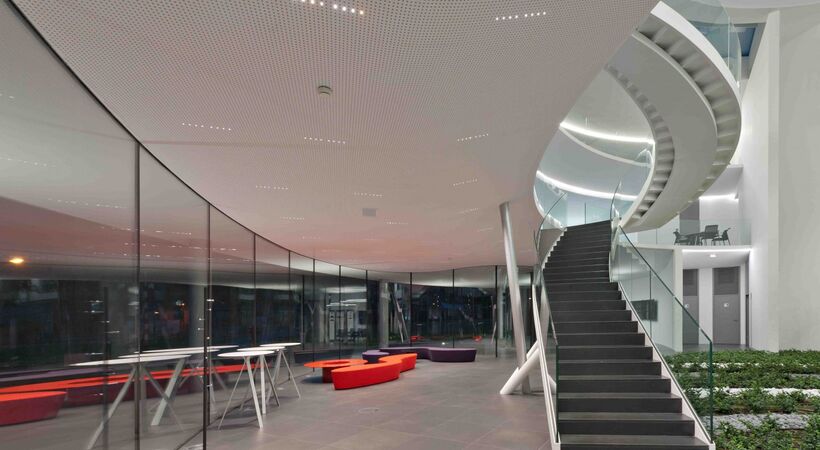A lighting control system is an essential element in any smart building. For the building services designer, simple to specify and install solutions can bring significant benefits. Pietari Tuomisto, product owner, embedded products at lighting intelligence expert, Helvar, offers some advice.
Investment in smart building technology is increasing. More and more organisations are recognising the benefits that integrating technology systems into a cohesive whole can bring to their operations. Whether its energy savings achieved through properly managing HVAC systems, or realising that having the lights blazing away in a half empty building is not an efficient (or cost effective) way to operate, organisations are investing in ‘smart’ technology and reaping the benefits. One area that should be of particular interest to the electrical designer is lighting control.
Lighting affects the way we feel. In winter with its shorter days and longer nights, it’s not uncommon for people to find their mood affected. Conversely, increased light levels (to the right degree) can enhance our wellbeing, increase productivity and help us to complete our tasks more effectively. Whether a corporate office, a school, or a hospital - a well-designed lighting scheme creates a brighter feeling to aid concentration and work performance in general.
However, it is not just a case of making the environment brighter, it is increasingly important to manage the light output in an appropriate fashion so as to maximise efficiency and energy consumption. Lighting consumes up to 40% of energy in a building and a lighting control system is the effective solution to both reducing this consumption level, and managing the ambience for maximum wellbeing. The key to success is finding the right blend of natural and artificial light sources.
One way to achieve this blend is through ‘daylight harvesting’ as it has become known in the industry. Daylight harvesting is the general description given to the exploitation of the natural daylight entering a room or area and the subsequent reduction of associated artificial lighting. Its use can provide a great deal of convenience for the buildings occupants, but perhaps the main reason for using it is that it provides a considerable increase in energy efficiency.
Although it sounds complex, daylight harvesting can be achieved by something as simple as incorporating sensors alongside luminaires in a lighting scheme. Lighting sensors generally come in two guises; PIR (passive infrared) for presence detection, and photocell for controlling ambient light levels. A good option, especially from a designer’s point of view (as it cuts down on wiring infrastructure), is a combined PIR/photocell sensor, recessed into the ceiling void, otherwise known as a multisensor.
A multisensor, such as the Helvar 321, monitors the level of natural light available in a room or corridor, and can adjust the artificial light level accordingly. The light sensor measures reflected light from the surface directly below it and uses this information to maintain a constant light level by adjusting the lamp outputs.
The integrated photocell sensor can dim the lights gradually when it detects increasing levels of natural light, and as natural light decreases, raise the artificial light level. This is accomplished in an imperceptible manner and the total light level in the room remains constant. It also ensures that the lighting scheme is perfectly optimised to consume only as much energy as required, no more, no less.
A further way to reduce the lighting system's use of energy is by ensuring that artificial lighting is only operating in those areas in which the building is occupied. The PIR function in a multisensor will automatically turn the lights on when a room is occupied and off when it is unoccupied. Efficient and reliable detection performance of presence and absence is key to the successful deployment of this type of sensor.
High sensitivity and multidirectional coverage are the important features to consider from a specification perspective. For example, the 321 picks up the smallest or slowest movements over extended periods of time, making it suitable for lecture theatres, classrooms and offices. This ensures that when the space is occupied by, say, someone working at a computer, the sensor will be able to detect the movement of a hand from keyboard to mouse or coffee mug and the lighting will remain on. Since its detection sensitivity is less dependent on movement direction than that of most PIR sensors, fewer units are required to reliably cover a target area which is good news for building services engineers, and their clients.
When putting a scheme together, it is important that components i.e. sensors, luminaire control gear, LED drivers, routers, ballasts etc, all operate on the same protocol. Although others are emerging, DALI – Digital Addressable Lighting Interface – is the best established protocol for digital lighting control systems. Another advantage is that occupancy sensors are available that can take their power from the DALI network, further minimising design and installation complexity and cost.
Thanks to the latest innovations on the market, deploying an energy efficient and controlled DALI lighting system with sophisticated benefits, such as, daylight harvesting and occupancy detection is within reach of electrical designers and their clients. Helvar’s intelligent technology in this area not only brings a new vibrancy and comfort to our human spaces, but also delivers with a performance and at a price point that’s more attractive than ever for end-users.
For further information, please visit www.helvar.com.





